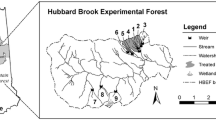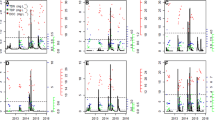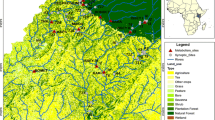Abstract
Stream and river ecosystems are dependent on energetic inputs from their watersheds and thus shifts in land use from forest cover to agriculture will affect stream community composition and function. The disruption of forest-aquatic linkages alters the organic matter resources in agricultural streams. Dissolved organic matter (DOM) is the dominant form of organic matter in aquatic ecosystems, and a microbial energy source that is important for stream respiration. The concentrations and characteristics of DOM are regulated by both terrestrial (for example, terrestrial organic matter supply) and in-stream processes (for example, microbial respiration and periphyton production) that are influenced by land management. The effects of watershed land use and topographic, soil and climatic variables on DOM quantity (dissolved organic carbon concentration and load), source (terrestrial or in-stream) and quality (composition and lability) were measured in 14 streams across an agricultural land-use gradient. DOC concentration was positively correlated with watershed pasture cover and negatively correlated with watershed relief. No watershed variables were important correlates of DOC load. Stream DOM was primarily of terrestrial origin, but DOM in agricultural streams had a greater proportion of sources from in-stream sources. This may be due to reduced connection with riparian vegetation and increased in-stream primary production. We suggest that maintaining watershed tree cover greater than 52% and ensuring less than 10% of the length of riparian corridor is cleared for pasture could minimize changes to DOM composition. This is important to avoid flow-on effects for stream ecosystem processes that are mediated by DOM. Long-term DOM monitoring will be valuable for assessing the functional impacts of land-use change.





Similar content being viewed by others
References
Allan J. 2004. Landscapes and riverscapes: the influence of land use on stream ecosystems. Ann Rev Ecol Evol Syst 35:257–84.
APHA. 2005. Standard methods for the examination of water and wastewater. 21st edn. Washington, DC: American Public Health Association.
Bernhardt ES, Likens GE. 2002. Dissolved organic carbon enrichment alters nitrogen dynamics in a forested stream. Ecology 83:1689–700.
Cammack WKL, Kalff J, Prairie YT, Smith EM. 2004. Fluorescent dissolved organic matter in lakes: relationships with heterotrophic metabolism. Limnol Oceanogr 49:2034–45.
Chin Y, Aiken G, O’Loughlin E. 1994. Molecular weight, polydispersity, and spectroscopic properties of aquatic humic substances. Environ Sci Technol 28:1853–8.
Cory N, Buffam I, Laudon H, Köhler S, Bishop K. 2006. Landscape control of stream water aluminum in a boreal catchment during spring flood. Environ Sci Technol 40:3494–500.
Cronan CS, Piampiano JT, Patterson HH. 1999. Influence of land use and hydrology on exports of carbon and nitrogen in a Maine river basin. J Environ Qual 28:953–62.
Dalrymple T, Benson MA. 1967. Measurement of peak discharge by the slope-area method. Techniques of water-resources investigations of the United States Geological Survey (Book 3, Chap. A-12). USGS, Washington, DC.
Dalzell BJ, King JY, Mulla DJ, Finlay JC, Sands GR. 2011. Influence of subsurface drainage on quantity and quality of dissolved organic matter export from agricultural landscapes. J Geophys Res 116:G02023.
Docherty K, Young K, Maurice P, Bridgham S. 2006. Dissolved organic matter concentration and quality influences upon structure and function of freshwater microbial communities. Microb Ecol 52:378–88.
Fellman JB, Hood E, Edwards RT, D’Amore DV. 2009. Changes in the concentration, biodegradability, and fluorescent properties of dissolved organic matter during stormflows in coastal temperate watersheds. J Geophys Res 114:G01021.
Follstad Shah JJ, Dahm CN, Gloss SP, Bernhardt ES. 2007. River and riparian restoration in the southwest: results of the national river restoration science synthesis project. Restor Ecol 15:550–62.
Gergel SE, Turner MG, Kratz TK. 1999. Dissolved organic carbon as an indicator of the scale of watershed influence on lakes and rivers. Ecol Appl 9:1377–90.
Hagen EM, McTammany ME, Webster JR, Benfield EF. 2010. Shifts in allochthonous input and autochthonous production in streams along an agricultural land-use gradient. Hydrobiologia 655:61–77.
Hooper DU, Chapin FSIII, Ewel JJ, Hector A, Inchausti P, Lavorel S, Lawton JH, Lodge DM, Loreau M, Naeem S, Schmid B, Setälä H, Symstad AJ, Vandermeer J, Wardle DA. 2005. Effects of biodiversity on ecosystem functioning: a consensus of current knowledge. Ecol Monogr 75:3–35.
Jaffé R, McKnight D, Maie N, Cory R, McDowell WH, Campbell JL. 2008. Spatial and temporal variations in DOM composition in ecosystems: The importance of long-term monitoring of optical properties. J Geophys Res 113:G04032.
Junk WJ, Bayley PB, Sparks RE. 1989. The flood pulse concept in river-floodplain systems. DP Dodge, editor. Proceedings of the international large river symposium. Can Spec Publ Fish Aquat Sci 106:110–27.
Kominoski JS, Rosemond AD. 2012. Conservation from the bottom up: forecasting effects of global change on dynamics of organic matter and management needs for river networks. Freshwater Sci 31:51–68.
Lake PS, Bond N, Reich P. 2007. Linking ecological theory with stream restoration. Freshwater Biol 52:597–615.
Lunn DJ, Thomas A, Best N, Spiegelhalter D. 2000. WinBUGS: a Bayesian modelling framework: concepts, structure, and extensibility. Stat Comput 10:325–37.
Mattsson T, Kortelainen P, Laubel A, Evans D, Pujo-Pay M, Räike A, Conan P. 2009. Export of dissolved organic matter in relation to land use along a European climatic gradient. Sci Total Environ 407:1967–76.
McKenzie NJ, Jacquier, DW, Ashton, LJ, Cresswell HP. 2000. Estimation of soil properties using the Atlas of Australian Soils. CSIRO Land and Water Technical Report 11/00.
McKnight DM, Boyer EW, Westerhoff PK, Doran PT, Kulbe T, Andersen DT. 2001. Spectrofluorometric characterization of dissolved organic matter for indication of precursor organic material and aromaticity. Limnol Oceanogr 46:38–48.
Molinero J, Burke R. 2009. Effects of land use on dissolved organic matter biogeochemistry in piedmont headwater streams of the Southeastern United States. Hydrobiologia 635:289–308.
Mulholland PJ. 1997. Dissolved organic matter concentration and flux in streams. J North Am Benthol Soc 16:131–41.
Mulholland PJ. 2003. Large-scale patterns in dissolved organic carbon concentration, flux, and sources. SEG Findlay, RL Sinsabaugh, editors. Aquatic Ecosystems: Interactivity of Dissolved Organic Matter. San Diego: Academic Press. p139-159.
Naiman RJ, Décamps H. 1997. The ecology of interfaces: riparian zones. Ann Rev Ecol Syst 28:621–58.
Nathan RJ, McMahon TA. 1990. Evaluation of automated techniques for base flow and recession analysis. Water Resour Res 26:1465–73.
Öhman K, Seibert J, Laudon H. 2009. An approach for including consideration of stream water dissolved organic carbon in long term forest planning. AMBIO 38:387–93.
Palmer MA, Febria CM. 2012. The heartbeat of ecosystems. Science 336:1393–4.
Quinn JM, Stroud MJ. 2002. Water quality and sediment and nutrient export from New Zealand hill-land catchments of contrasting land use. N Z J Mar Freshwater Res 36:409–29.
Ramachandran Nair PK, Mohan Kumar B, Nair VD. 2009. Agroforestry as a strategy for carbon sequestration. J Plant Nutr Soil Sci 172:10–23.
Ramankutty N, Evan AT, Monfreda C, Foley JA. 2008. Farming the planet: 1. Geographic distribution of global agricultural lands in the year 2000. Glob Biogeochem Cycles 22: GB1003.
Roberts B, Mulholland P, Hill W. 2007. Multiple scales of temporal variability in ecosystem metabolism rates: Results from 2 years of continuous monitoring in a forested headwater stream. Ecosystems 10:588–606.
Royer TV, David MB. 2005. Export of dissolved organic carbon from agricultural streams in Illinois, USA. Aquat Sci 67:465–71.
Sakamaki T, Richardson JS. 2011. Biogeochemical properties of fine particulate organic matter as an indicator of local and catchment impacts on forested streams. J Appl Ecol 48:1462–71.
Servais P, Anzil A, Ventresque C. 1989. Simple method for determination of biodegradable dissolved organic carbon in water. Appl Environ Microbiol 55:2732–4.
Stanley EH, Powers SM, Lottig NR, Buffam I, Crawford JT. 2012. Contemporary changes in dissolved organic carbon (DOC) in human-dominated rivers: is there a role for DOC management? Freshwater Biol 57(Suppl. 1):26–42.
Stedmon CA, Markager S, Bro R. 2003. Tracing dissolved organic matter in aquatic environments using a new approach to fluorescence spectroscopy. Marine Chem 82:239–54.
Stein JL, Stein JA, Nix HA. 2002. Spatial analysis of anthropogenic river disturbance at regional and continental scales: identifying the wild rivers of Australia. Landsc Urban Plan 60:1–25.
Sweeney BW, Bott TL, Jackson JK, Kaplan LA, Newbold JD, Standley LJ, Hession WC, Horwitz RJ. 2004. Riparian deforestation, stream narrowing, and loss of stream ecosystem services. PNAS 101:14132–7.
Tilman D, Balzer C, Hill J, Befort BL. 2011. Global food demand and the sustainable intensification of agriculture. Proc Nat Acad Sci 108:20260–4.
Townsend CR, Thompson RM, McIntosh AR, Kilroy C, Edwards E, Scarsbrook MR. 1998. Disturbance, resource supply, and food-web architecture in streams. Ecol Lett 1:200–9.
Victorian Department of Sustainability and Environment. 2012. Ensym (Version 9.5.0) [Computer software]. Retrieved from https://ensym.dse.vic.gov.au.
Wallace JB, Eggert SL, Meyer JL, Webster JR. 1997. Multiple trophic levels of a forest stream linked to terrestrial litter inputs. Science 277:102–4.
Wiegner TN, Kaplan LA, Newbold JD, Ostrom PH. 2005. Contribution of dissolved organic C to stream metabolism: a mesocosm study using 13C-enriched tree-tissue leachate. J North Am Benthol Soc 24:48–67.
Williams CJ, Yamashita Y, Wilson HF, Jaffe R, Xenopoulos MA. 2010. Unraveling the role of land use and microbial activity in shaping dissolved organic matter characteristics in stream ecosystems. Limnol Oceanogr 55:1159–71.
Wilson H, Xenopoulos M. 2008. Ecosystem and seasonal control of stream dissolved organic carbon along a gradient of land use. Ecosystems 11:555–68.
Wilson HF, Xenopoulos MA. 2009. Effects of agricultural land use on the composition of fluvial dissolved organic matter. Nat Geosci 2:37–41.
Woodward G, Gessner MO, Giller PS, Gulis V, Hladyz S, Lecerf A, Malmqvist B, McKie BG, Tiegs SD, Cariss H, Dobson M, Elosegi A, Ferreira V, Graça MAS, Fleituch T, Lacoursière JO, Nistorescu M, Pozo J, Risnoveanu G, Schindler M, Vadineanu A, Vought LB-M, Chauvet E. 2012. Continental-scale effects of nutrient pollution on stream ecosystem functioning. Science 336:1438–40.
Yamashita Y, Kloeppel B, Knoepp J, Zausen G, Jaffé R. 2011. Effects of watershed history on dissolved organic matter characteristics in headwater streams. Ecosystems 14:1110–22.
Yang L, Hong H, Guo W, Huang J, Li Q, Yu X. 2012. Effects of changing land use on dissolved organic matter in a subtropical river watershed, southeast China. Reg Environ Chang 12:145–51.
Zeng K, H-m Hwang, Yuzuri H. 2002. Effect of dissolved humic substances on the photochemical degradation rate of 1-aminopyrene and atrazine. Int J Mol Sci 3:1048–57.
Acknowledgments
This study was completed with funding from an ARC Linkage Grant (LP0990038) and the Holsworth Wildlife Research Endowment. We acknowledge Charles Showers (DSE Environmental Economics Unit) for EnSym assistance and Colin Stedmon for help with EEM corrections. Field and lab assistance was provided by Shaun Cunningham, Samantha Imberger, Adrian Dusting, Laura Caffrey, Glenn Jepson, Scott McDonald, Phil De Zylva, Chris McCormack, Gillian Cromie and Darren Steiert. Two anonymous reviewers provided valuable comments on earlier versions.
Author information
Authors and Affiliations
Corresponding author
Additional information
Author Contribution
DPG performed the research and wrote the paper; MRG contributed new methods and contributed to writing; JRT analyzed data and contributed new methods and modeling; RM and RMT conceived of the study and contributed to writing.
Electronic supplementary material
Below is the link to the electronic supplementary material.
Rights and permissions
About this article
Cite this article
Giling, D.P., Grace, M.R., Thomson, J.R. et al. Effect of Native Vegetation Loss on Stream Ecosystem Processes: Dissolved Organic Matter Composition and Export in Agricultural Landscapes. Ecosystems 17, 82–95 (2014). https://doi.org/10.1007/s10021-013-9708-6
Received:
Accepted:
Published:
Issue Date:
DOI: https://doi.org/10.1007/s10021-013-9708-6




